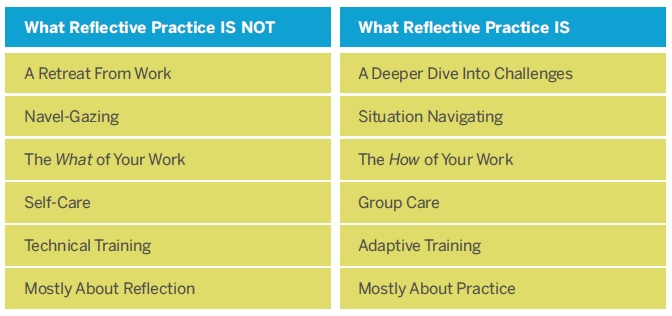Reflective practices to #ShiftThePower
As a practitioner in philanthropy you know there is a big difference between talking about strategy and living a strategy. One is a plan, hopefully well written and widely vetted, with goals, metrics and tactics. If it is good, a strategy can feel like it is real on paper. However, once a strategy comes into play – especially if it is about systemic change or transformation in a field or a community – the terrain you travel is not the paper’s high hard ground with wayfaring signs, well-trodden paths and signals. Rather, it is what the philosopher and management theorist Don Schön called “the swampy lowlands” where what to do is more uncertain and progress is neither linear nor clear.
This lowland terrain is where most important and complex work takes place. We often find ourselves there as we move from talking about shifting power to making it happen. Think about co-creating a proposal, organizing a new collaborative with partners who have different perspectives, discovering an implicit bias tied to “how we do things here” with a donor or inside a foundation.
This is the work we most want to do but that doesn’t make it easy to sustain. How Community Philanthropy Shifts Power: What Donors Can Do to Help Make that Happen offers us interesting tools and tactics. I loved reading the report. It reminded me of why we started GrantCraft at the Ford Foundation. We wanted to help philanthropy practitioners learn from each other’s experiences with important, challenging work on the job.
I believe that we can help each other do a better job of using these tools and techniques when we remember to add a reflective practice lens over the challenges that inevitably will come up as we put newly acquired expertise into play in philanthropy.
Reflective practice is not new and it is not a technical term. There is a long history of reflective practices used to aid discernment as a spiritual practice in different traditions. Since the twentieth century, reflective practice has become part of professional development and onboarding programmes in a variety of professions – education, social work, medicine and nursing to name a few – to help practitioners learn to navigate challenges that arise in challenging experiences on-the-job.
A reflective practice usually has three elements:
- Being curious and openly observing oneself and others in action.
- Inviting individuals and groups to dive “beneath the waterline” of freighted conversations or stuck situations to surface new information.
- Creating experiments to test and learn from adjustments in behavior.
Reflection can seem like a luxury or self-indulgent compared to the problems that a strategy is designed to solve. On top of that, there is the perennial lack of time to pause and reflect on what is happening in the moment. Finally, there is the fear that reflection might reveal what we don’t know. Paradoxically, reflective practices can fuel new knowledge and change.

Over the last few years, I’ve been inviting and listening to stories from philanthropy practitioners about their experience navigating challenging situations where collaboration and innovative thinking with others was essential to get to better outcomes. These practitioner experiences inevitably reference the tension GFCF Executive Director Jenny Hodgson described in an earlier blog as moments when “power is central, shaping the ways in which people treat each other and expect to be treated at one end, and the culture and structures of big institutions at the other.”
Practitioners shared reflective practices that they and their partners used to construct bridges over what seemed like formidable terrain. As a result of their stories and the patterns we found within them, we created a guide to share four core practices: discovering roles; practicing presence; using the right brain and enlisting peers.
What we love about these four practices is that they are easy to use. No new language needs to be acquired to become proficient in any of them. They take time that can be incorporated into existing meetings and conversations. Retreats are not required. They are premised on the value of diversity, equity and inclusion by inviting everyone involved in a stuck moment to observe without judgement and solve puzzles together. Best of all, most of us already have a hidden or unconscious practice that includes some of the elements of the four core practices. Making any of these a discipline is a matter of being explicit about reflecting on practice, borrowing a few ideas and regularly using them.
Is your reflective practice here? If you’d like to share how that practice helped you #ShiftThePower, contact me to post it at www.reflectivepractices.org.
Editor's Note: This blog originally appeared on Global Fund for Community Foundations.

